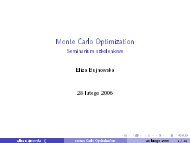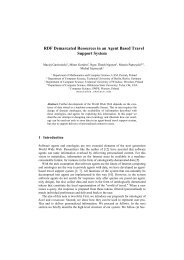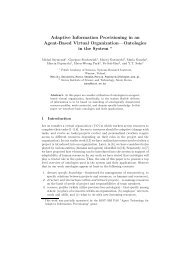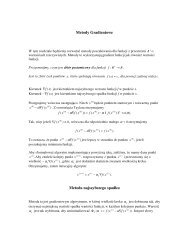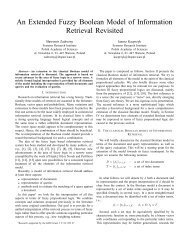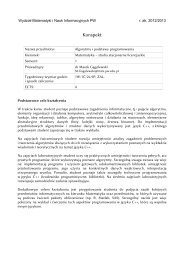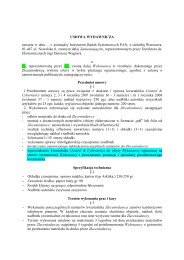Knowledge Management in an E-commerce System
Knowledge Management in an E-commerce System
Knowledge Management in an E-commerce System
You also want an ePaper? Increase the reach of your titles
YUMPU automatically turns print PDFs into web optimized ePapers that Google loves.
<strong>Knowledge</strong> <strong>M<strong>an</strong>agement</strong> <strong>in</strong> <strong>an</strong> E-<strong>commerce</strong> <strong>System</strong> 10this. In general, the ma<strong>in</strong> goal of content personalization, as viewed from the e-<strong>commerce</strong> perspective, is to support theclient-system <strong>in</strong>teractions <strong>an</strong>d provide a quality substitute for the miss<strong>in</strong>g hum<strong>an</strong> salesperson. In particular, throughpersonalization the system aims at: provid<strong>in</strong>g a better quality of buy<strong>in</strong>g experience through underst<strong>an</strong>d<strong>in</strong>g <strong>an</strong>d predict<strong>in</strong>gneeds of <strong>in</strong>dividual customers, improvement of satisfaction of the customer, improved effectiveness of the system (asmeasured through the total number of items sold to each client), build<strong>in</strong>g of a br<strong>an</strong>d recognition <strong>an</strong>d a relationshipbetween clients <strong>an</strong>d e-stores, that will result <strong>in</strong> customer return<strong>in</strong>g <strong>an</strong>d mak<strong>in</strong>g additional purchases of commodities.Be<strong>in</strong>g able to directly <strong>in</strong>teract with the client <strong>an</strong>d track all of the <strong>in</strong>teractions (see Section 2), allows the system to get toknow the client <strong>an</strong>d to adjust the offer to her expectations. In addition it allows the system to <strong>in</strong>fluence her choices as wellas promote new products. An ontology designed for personalization comb<strong>in</strong>es knowledge about products <strong>an</strong>d associatedsale strategies comb<strong>in</strong>ed with knowledge of the customer <strong>in</strong> order to make relev<strong>an</strong>t suggestions. In addition, generalknowledge about products comb<strong>in</strong>ed with the <strong>an</strong>alysis of market trends <strong>an</strong>d client cluster<strong>in</strong>g allows the system to achievesuccess <strong>in</strong> deal<strong>in</strong>g with new clients. Summariz<strong>in</strong>g, the personalization eng<strong>in</strong>e perspective <strong>in</strong>corporates knowledge ofusers (described terms of populations, clusters <strong>an</strong>d <strong>in</strong>dividuals), sale strategies as well as supply dynamics.5.4 Org<strong>an</strong>izationalIn our earlier work <strong>an</strong>alyz<strong>in</strong>g abstractions of a real e-<strong>commerce</strong> system, we divided the functions of the system <strong>in</strong>tosupply support (SS) <strong>an</strong>d customer support (CS) subsystems, which <strong>in</strong>teract via a communication ch<strong>an</strong>nel [9]. Theknowledge m<strong>an</strong>agement of the system may be viewed similarly: the knowledge utilized by the supply subsystem islargely system knowledge, required for the support of tr<strong>an</strong>saction m<strong>an</strong>agement (buy<strong>in</strong>g <strong>an</strong>d sell<strong>in</strong>g) <strong>an</strong>d commoditym<strong>an</strong>agement (selection, delivery <strong>an</strong>d <strong>in</strong>ventory). The customer subsystem, on the other h<strong>an</strong>d, mimics the role of a hum<strong>an</strong>seller, support<strong>in</strong>g the customer <strong>in</strong> search<strong>in</strong>g, select<strong>in</strong>g <strong>an</strong>d purchas<strong>in</strong>g merch<strong>an</strong>dise [9]. These subsystems are largely<strong>an</strong>alogous to those found <strong>in</strong> well-established hum<strong>an</strong> org<strong>an</strong>izations: production <strong>an</strong>d development on one side <strong>an</strong>dmarket<strong>in</strong>g <strong>an</strong>d customer relations on the other.While knowledge about suppliers is mostly localized <strong>in</strong> the SS subsystem <strong>an</strong>d knowledge about customers is <strong>in</strong> theCS subsystem, the two spheres are <strong>in</strong>terdependent. The success of <strong>an</strong>y form of <strong>commerce</strong> lies <strong>in</strong> the reconciliation ofcustomer <strong>in</strong>terests with bus<strong>in</strong>ess objectives, <strong>an</strong>d e-<strong>commerce</strong> is no different <strong>in</strong> this sense. Consider that one of the goalsof the supply system is to sell the commodity it has the most of (<strong>in</strong> order to reduce <strong>in</strong>ventory) as well as the products thatare most profitable. This knowledge of products must be tr<strong>an</strong>sferred to the CS subsystem so that these products c<strong>an</strong> bepromoted, particularly to a target base of customers who are more likely to purchase them. On the other h<strong>an</strong>d, the supplysystem must const<strong>an</strong>tly accept feedback from the customer support system, <strong>in</strong> order to match the supply of a product toits dem<strong>an</strong>d. Similarly, a customer may have <strong>in</strong>dividual desires, which are not satisfied by a general selection ofcommodities, <strong>an</strong>d these must also be taken <strong>in</strong>to account by the supply system. <strong>Knowledge</strong> of this customer <strong>an</strong>d hisexpectations are crucial to both the CS <strong>an</strong>d SS subsystems – “the customer is always right” still applies to e-<strong>commerce</strong>,<strong>an</strong>d <strong>in</strong> fact it is even more import<strong>an</strong>t because of the customer’s additional expectations. F<strong>in</strong>ally, knowledge of the outsideworld is pert<strong>in</strong>ent to both subsystems: the system must function realistically (as described above) as well as follow trends<strong>an</strong>d other <strong>in</strong>formation that is not mediated through the customer <strong>an</strong>d supply sides. An ontology for the CS-SS modelsencompasses knowledge from hum<strong>an</strong> m<strong>an</strong>agement experts, product pl<strong>an</strong>ners <strong>an</strong>d supply-side coord<strong>in</strong>ators as well as thatfrom customers relations specialists. It also <strong>in</strong>cludes knowledge describ<strong>in</strong>g the <strong>in</strong>ternal processes of successfulorg<strong>an</strong>izations, from <strong>an</strong>d upon which the system may adapt <strong>an</strong>d grow through its cont<strong>in</strong>ual operation <strong>in</strong> the market.5.5 Customer support strategiesThis ontology subsumes that of personalization, <strong>an</strong>d references the entirety of knowledge necessary for serv<strong>in</strong>gcustomers. Thus there is some overlap with the economic, org<strong>an</strong>izational <strong>an</strong>d multiple other ontologies that relate toknowledge of customer support. Here the e-<strong>commerce</strong> system is perceived as a me<strong>an</strong>s to the end of customer satisfaction– “the customer is always right” – <strong>an</strong>d we consider m<strong>an</strong>y qualifications for this, for <strong>in</strong>st<strong>an</strong>ce:- <strong>in</strong>teraction with the system (easy to use, aesthetically pleas<strong>in</strong>g),- r<strong>an</strong>ge of commodities offered,- quality of service – timel<strong>in</strong>ess, returns, responsiveness to feedback, etc.,International Conference on Electronic Commerce Research (ICECR-5)



